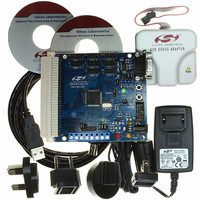C8051F120DK Silicon Laboratories Inc, C8051F120DK Datasheet - Page 34

C8051F120DK
Manufacturer Part Number
C8051F120DK
Description
DEVKIT-F120/21/22/23/24/25/26/27
Manufacturer
Silicon Laboratories Inc
Type
MCUr
Datasheet
1.C8051F120DK.pdf
(350 pages)
Specifications of C8051F120DK
Contents
Evaluation Board, Power Supply, USB Cables, Adapter and Documentation
Processor To Be Evaluated
C8051F12x and C8051F13x
Interface Type
USB
Silicon Manufacturer
Silicon Labs
Core Architecture
8051
Silicon Core Number
C8051F120
Silicon Family Name
C8051F12x
Lead Free Status / RoHS Status
Contains lead / RoHS non-compliant
For Use With/related Products
C8051F120, 121, 122, 123, 124, 125, 126, 127
Lead Free Status / Rohs Status
Lead free / RoHS Compliant
Other names
336-1224
Available stocks
Company
Part Number
Manufacturer
Quantity
Price
Company:
Part Number:
C8051F120DK
Manufacturer:
SiliconL
Quantity:
4
- Current page: 34 of 350
- Download datasheet (2Mb)
C8051F120/1/2/3/4/5/6/7
C8051F130/1/2/3
1.8.
All devices include either a 12 or 10-bit SAR ADC (ADC0) with a 9-channel input multiplexer and program-
mable gain amplifier. With a maximum throughput of 100 ksps, the 12 and 10-bit ADCs offer true 12-bit lin-
earity with an INL of ±1LSB. The ADC0 voltage reference can be selected from an external VREF pin, or
(on the C8051F12x devices) the DAC0 output. On the 100-pin TQFP devices, ADC0 has its own dedicated
Voltage Reference input pin; on the 64-pin TQFP devices, the ADC0 shares a Voltage Reference input pin
with the 8-bit ADC2. The on-chip voltage reference may generate the voltage reference for other system
components or the on-chip ADCs via the VREF output pin.
The ADC is under full control of the CIP-51 microcontroller via its associated Special Function Registers.
One input channel is tied to an internal temperature sensor, while the other eight channels are available
externally. Each pair of the eight external input channels can be configured as either two single-ended
inputs or a single differential input. The system controller can also put the ADC into shutdown mode to
save power.
A programmable gain amplifier follows the analog multiplexer. The gain can be set in software from 0.5 to
16 in powers of 2. The gain stage can be especially useful when different ADC input channels have widely
varied input voltage signals, or when it is necessary to "zoom in" on a signal with a large DC offset (in dif-
ferential mode, a DAC could be used to provide the DC offset).
Conversions can be started in four ways; a software command, an overflow of Timer 2, an overflow of
Timer 3, or an external signal input. This flexibility allows the start of conversion to be triggered by software
events, external HW signals, or a periodic timer overflow signal. Conversion completions are indicated by a
status bit and an interrupt (if enabled). The resulting 10 or 12-bit data word is latched into two SFRs upon
completion of a conversion. The data can be right or left justified in these registers under software control.
Window Compare registers for the ADC data can be configured to interrupt the controller when ADC data
is within or outside of a specified range. The ADC can monitor a key voltage continuously in background
mode, but not interrupt the controller unless the converted data is within the specified window.
34
AIN0.0
AIN0.1
AIN0.2
AIN0.3
AIN0.4
AIN0.5
AIN0.6
AIN0.7
12 or 10-Bit Analog to Digital Converter
Analog Multiplexer
AGND
SENSOR
TEMP
+
+
+
+
-
-
-
-
AMUX
(SE or
9-to-1
DIFF)
Figure 1.13. 12-Bit ADC Block Diagram
Programmable Gain
X
Amplifier
Configuration, Control, and Data
External VREF
+
-
DAC0 Output
AV+
Rev. 1.4
Registers
Pin
ADC
VREF
12-Bit
SAR
Start
Conversion
Window Compare
12
Logic
Write to AD0BUSY
Timer 3 Overflow
CNVSTR0
Timer 2 Overflow
ADC Data
Registers
Conversion
Complete
Compare
Interrupt
Interrupt
Window
Related parts for C8051F120DK
Image
Part Number
Description
Manufacturer
Datasheet
Request
R
Part Number:
Description:
SMD/C°/SINGLE-ENDED OUTPUT SILICON OSCILLATOR
Manufacturer:
Silicon Laboratories Inc
Part Number:
Description:
Manufacturer:
Silicon Laboratories Inc
Datasheet:
Part Number:
Description:
N/A N/A/SI4010 AES KEYFOB DEMO WITH LCD RX
Manufacturer:
Silicon Laboratories Inc
Datasheet:
Part Number:
Description:
N/A N/A/SI4010 SIMPLIFIED KEY FOB DEMO WITH LED RX
Manufacturer:
Silicon Laboratories Inc
Datasheet:
Part Number:
Description:
N/A/-40 TO 85 OC/EZLINK MODULE; F930/4432 HIGH BAND (REV E/B1)
Manufacturer:
Silicon Laboratories Inc
Part Number:
Description:
EZLink Module; F930/4432 Low Band (rev e/B1)
Manufacturer:
Silicon Laboratories Inc
Part Number:
Description:
I°/4460 10 DBM RADIO TEST CARD 434 MHZ
Manufacturer:
Silicon Laboratories Inc
Part Number:
Description:
I°/4461 14 DBM RADIO TEST CARD 868 MHZ
Manufacturer:
Silicon Laboratories Inc
Part Number:
Description:
I°/4463 20 DBM RFSWITCH RADIO TEST CARD 460 MHZ
Manufacturer:
Silicon Laboratories Inc
Part Number:
Description:
I°/4463 20 DBM RADIO TEST CARD 868 MHZ
Manufacturer:
Silicon Laboratories Inc
Part Number:
Description:
I°/4463 27 DBM RADIO TEST CARD 868 MHZ
Manufacturer:
Silicon Laboratories Inc
Part Number:
Description:
I°/4463 SKYWORKS 30 DBM RADIO TEST CARD 915 MHZ
Manufacturer:
Silicon Laboratories Inc
Part Number:
Description:
N/A N/A/-40 TO 85 OC/4463 RFMD 30 DBM RADIO TEST CARD 915 MHZ
Manufacturer:
Silicon Laboratories Inc
Part Number:
Description:
I°/4463 20 DBM RADIO TEST CARD 169 MHZ
Manufacturer:
Silicon Laboratories Inc











